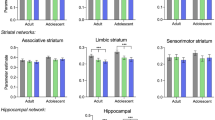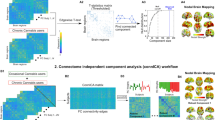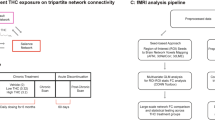Abstract
There is now considerable evidence to support the hypothesis that psychotic symptoms are the result of abnormal salience attribution, and that the attribution of salience is largely mediated through the prefrontal cortex, the striatum, and the hippocampus. Although these areas show differential activation under the influence of delta-9-tetrahydrocannabinol (delta-9-THC) and cannabidiol (CBD), the two major derivatives of cannabis sativa, little is known about the effects of these cannabinoids on the functional connectivity between these regions. We investigated this in healthy occasional cannabis users by employing event-related functional magnetic resonance imaging (fMRI) following oral administration of delta-9-THC, CBD, or a placebo capsule. Employing a seed cluster-based functional connectivity analysis that involved using the average time series from each seed cluster for a whole-brain correlational analysis, we investigated the effect of drug condition on functional connectivity between the seed clusters and the rest of the brain during an oddball salience processing task. Relative to the placebo condition, delta-9-THC and CBD had opposite effects on the functional connectivity between the dorsal striatum, the prefrontal cortex, and the hippocampus. Delta-9-THC reduced fronto-striatal connectivity, which was related to its effect on task performance, whereas this connection was enhanced by CBD. Conversely, mediotemporal-prefrontal connectivity was enhanced by delta-9-THC and reduced by CBD. Our results suggest that the functional integration of brain regions involved in salience processing is differentially modulated by single doses of delta-9-THC and CBD and that this relates to the processing of salient stimuli.
Similar content being viewed by others
Log in or create a free account to read this content
Gain free access to this article, as well as selected content from this journal and more on nature.com
or
References
Asplund CL, Todd JJ, Snyder AP, Marois R (2010). A central role for the lateral prefrontal cortex in goal-directed and stimulus-driven attention. Nat Neurosci 13: 507–512.
Batalla A, Bhattacharyya S, Yücel M, Fusar-Poli P, Crippa JA, Nogué S et al (2013). Structural and functional imaging studies in chronic cannabis users: a systematic review of adolescent and adult findings. PLoS ONE 8: e55821.
Bhattacharyya S, Atakan Z, Martin-Santos R, Crippa JA, Kambeitz J, Prata D et al (2012a). Preliminary report of biological basis of sensitivity to the effects of cannabis on psychosis: AKT1 and DAT1 genotype modulates the effects of δ-9-tetrahydrocannabinol on midbrain and striatal function. Mol Psychiatry 17: 1152–1155.
Bhattacharyya S, Atakan Z, Martin-Santos R, Crippa JA, McGuire PK (2012b). Neural mechanisms for the cannabinoid modulation of cognition and affect in man: a critical review of neuroimaging studies. Curr Pharm Des 18: 5045–5054.
Bhattacharyya S, Crippa JA, Allen P, Martin-Santos R, Borgwardt S, Fusar-Poli P et al (2012c). Induction of psychosis by Δ9-tetrahydrocannabinol reflects modulation of prefrontal and striatal function during attentional salience processing. Arch Gen Psychiatry 69: 27–36.
Bhattacharyya S, Crippa JA, Martin-Santos R, Winton-Brown T, Fusar-Poli P (2009a). Imaging the neural effects of cannabinoids: current status and future opportunities for psychopharmacology. Curr Pharm Des 15: 2603–2614.
Bhattacharyya S, Fusar-Poli P, Borgwardt S, Martin-Santos R, Nosarti C, O’Carroll C et al (2009b). Modulation of mediotemporal and ventrostriatal function in humans by Delta9-tetrahydrocannabinol: a neural basis for the effects of Cannabis sativa on learning and psychosis. Arch Gen Psychiatry 66: 442–451.
Bhattacharyya S, Morrison PD, Fusar-Poli P, Martin-Santos R, Borgwardt S, Winton-Brown T et al (2010). Opposite effects of delta-9-tetrahydrocannabinol and cannabidiol on human brain function and psychopathology. Neuropsychopharmacology 35: 764–774.
Bolton MM, Heaney CF, Sabbagh JJ, Murtishaw AS, Magcalas CM, Kinney JW (2012). Deficits in emotional learning and memory in an animal model of schizophrenia. Behav Brain Res 233: 35–44.
Borgwardt SJ, Allen P, Bhattacharyya S, Fusar-Poli P, Crippa JA, Seal ML et al (2008). Neural basis of Delta-9-tetrahydrocannabinol and cannabidiol: effects during response inhibition. Biol Psychiatry 64: 966–973.
Brammer MJ, Bullmore ET, Simmons A, Williams SC, Grasby PM, Howard RJ et al (1997). Generic brain activation mapping in functional magnetic resonance imaging: a nonparametric approach. Magn Reson Imaging 15: 763–770.
Bullmore E, Long C, Suckling J, Fadili J, Calvert G, Zelaya F et al (2001). Colored noise and computational inference in neurophysiological (fMRI) time series analysis: resampling methods in time and wavelet domains. Hum Brain Mapp 12: 61–78.
Burianova H, McIntosh AR, Grady CL (2010). A common functional brain network for autobiographical, episodic, and semantic memory retrieval. Neuroimage 49: 865–874.
Corlett PR, Honey GD, Aitken MRF, Dickinson A, Shanks DR, Absalom AR et al (2006). Frontal responses during learning predict vulnerability to the psychotogenic effects of ketamine: linking cognition, brain activity, and psychosis. Arch Gen Psychiatry 63: 611–621.
Crippa JA, Zuardi AW, Martín-Santos R, Bhattacharyya S, Atakan Z, McGuire P et al (2009). Cannabis and anxiety: a critical review of the evidence. Hum Psychopharmacol 24: 515–523.
D’Souza DC, Perry E, MacDougall L, Ammerman Y, Cooper T, Wu Y-T et al (2004). The psychotomimetic effects of intravenous delta-9-tetrahydrocannabinol in healthy individuals: implications for psychosis. Neuropsychopharmacology 29: 1558–1572.
D’Souza DC, Abi-Saab WM, Madonick S, Forselius-Bielen K, Doersch A, Braley G et al (2005). Delta-9-tetrahydrocannabinol effects in schizophrenia: implications for cognition, psychosis, and addiction. Biol Psychiatry 57: 594–608.
Diaconescu AO, Menon M, Jensen J, Kapur S, McIntosh AR (2010). Dopamine-induced changes in neural network patterns supporting aversive conditioning. Brain Res 1313: 143–161.
Esposito R, Cilli F, Pieramico V, Ferretti A, Macchia A, Tommasi M et al (2013). Acute effects of modafinil on brain resting state networks in young healthy subjects. PLoS ONE 8: e69224.
Filbey F, Yezhuvath U (2013). Functional connectivity in inhibitory control networks and severity of cannabis use disorder. Am J Drug Alcohol Abuse 39: 382–391.
Floresco SB, West AR, Ash B, Moore H, Grace AA (2003). Afferent modulation of dopamine neuron firing differentially regulates tonic and phasic dopamine transmission. Nat Neurosci 6: 968–973.
Friston KJ (2011). Functional and effective connectivity: a review. Brain Connect 1: 13–36.
Fusar-Poli P, Allen P, Bhattacharyya S, Crippa JA, Mechelli A, Borgwardt S et al (2010). Modulation of effective connectivity during emotional processing by Delta 9-tetrahydrocannabinol and cannabidiol. Int J Neuropsychopharmacol 13: 421–432.
Fusar-Poli P, Crippa JA, Bhattacharyya S, Borgwardt SJ, Allen P, Martin-Santos R et al (2009). Distinct effects of {delta}9-tetrahydrocannabinol and cannabidiol on neural activation during emotional processing. Arch Gen Psychiatry 66: 95–105.
Gollub RL, Breiter HC, Kantor H, Kennedy D, Gastfriend D, Mathew RT et al (1998). Cocaine decreases cortical cerebral blood flow but does not obscure regional activation in functional magnetic resonance imaging in human subjects. J Cereb Blood Flow Metab 18: 724–734.
Guillin O, Abi-Dargham A, Laruelle M (2007). Neurobiology of dopamine in schizophrenia. Int Rev Neurobiol 78: 1–39.
Jensen J, Kapur S (2009). Salience and psychosis: moving from theory to practise. Psychol Med 39: 197–198.
Kay SR, Fiszbein A, Opler LA (1987). The positive and negative syndrome scale (PANSS) for schizophrenia. Schizophr Bull 13: 261.
Kuepper R, Morrison PD, van Os J, Murray RM, Kenis G, Henquet C (2010). Does dopamine mediate the psychosis-inducing effects of cannabis? A review and integration of findings across disciplines. Schizophr Res 121: 107–117.
Kuepper R, van Os J, Lieb R, Wittchen H-U, Höfler M, Henquet C (2011). Continued cannabis use and risk of incidence and persistence of psychotic symptoms: 10 year follow-up cohort study. BMJ 342: d738.
Kumaran D, Maguire EA (2006). An unexpected sequence of events: mismatch detection in the human hippocampus. PLoS Biol 4: e424.
Laviolette SR, Grace AA (2006). Cannabinoids potentiate emotional learning plasticity in neurons of the medial prefrontal cortex through basolateral amygdala inputs. J Neurosci 26: 6458–6468.
Leweke FM, Piomelli D, Pahlisch F, Muhl D, Gerth CW, Hoyer C et al (2012). Cannabidiol enhances anandamide signaling and alleviates psychotic symptoms of schizophrenia. Transl Psychiatry 2: e94.
Luo F, Wu G, Li Z, Li S-J (2003). Characterization of effects of mean arterial blood pressure induced by cocaine and cocaine methiodide on BOLD signals in rat brain. Magn Reson Med 49: 264–270.
Meyer-Lindenberg A (2010). From maps to mechanisms through neuroimaging of schizophrenia. Nature 468: 194–202.
Moore THM, Zammit S, Lingford-Hughes A, Barnes TRE, Jones PB, Burke M et al (2007). Cannabis use and risk of psychotic or affective mental health outcomes: a systematic review. Lancet 370: 319–328.
Morgan CJA, Curran HV (2008). Effects of cannabidiol on schizophrenia-like symptoms in people who use cannabis. Br J Psychiatry 192: 306–307.
Morgan CJA, Freeman TP, Schafer GL, Curran HV (2010a). Cannabidiol attenuates the appetitive effects of Delta 9-tetrahydrocannabinol in humans smoking their chosen cannabis. Neuropsychopharmacology 35: 1879–1885.
Morgan CJA, Schafer G, Freeman TP, Curran HV (2010b). Impact of cannabidiol on the acute memory and psychotomimetic effects of smoked cannabis: naturalistic study: naturalistic study [corrected]. Br J Psychiatry 197: 285–290.
Morrison PD, Nottage J, Stone JM, Bhattacharyya S, Tunstall N, Brenneisen R et al (2011). Disruption of frontal theta coherence by Δ9-tetrahydrocannabinol is associated with positive psychotic symptoms. Neuropsychopharmacology 36: 827–836.
Murphy K, Dixon V, LaGrave K, Kaufman J, Risinger R, Bloom A et al (2006). A validation of event-related fMRI comparisons between users of cocaine, nicotine, or cannabis and control subjects. Am J Psychiatry 163: 1245–1251.
Palaniyappan L, Liddle PF (2012). Does the salience network play a cardinal role in psychosis? An emerging hypothesis of insular dysfunction. J Psychiatry Neurosci 37: 17–27.
Pertwee RG (2008). The diverse CB1 and CB2 receptor pharmacology of three plant cannabinoids: delta9-tetrahydrocannabinol, cannabidiol and delta9-tetrahydrocannabivarin. Br J Pharmacol 153: 199–215.
Pettersson-Yeo W, Allen P, Benetti S, McGuire P, Mechelli A (2011). Dysconnectivity in schizophrenia: where are we now? Neurosci Biobehav Rev 35: 1110–1124.
Pujol J, Blanco-Hinojo L, Batalla A, López-Solà M, Harrison BJ, Soriano-Mas C et al (2013). Functional connectivity alterations in brain networks relevant to self-awareness in chronic cannabis users. J Psychiatr Res 51: 68–78.
Rubia K, Smith AB, Brammer MJ, Taylor E (2007). Temporal lobe dysfunction in medication-naïve boys with attention-deficit/hyperactivity disorder during attention allocation and its relation to response variability. Biol Psychiatry 62: 999–1006.
Salvadore G, Cornwell BR, Sambataro F, Latov D, Colon-Rosario V, Carver F et al (2010). Anterior cingulate desynchronization and functional connectivity with the amygdala during a working memory task predict rapid antidepressant response to ketamine. Neuropsychopharmacology 35: 1415–1422.
Selemon LD, Goldman-Rakic PS (1985). Longitudinal topography and interdigitation of corticostriatal projections in the rhesus monkey. J Neurosci 5: 776–794.
Stone JM, Morrison PD, Brugger S, Nottage J, Bhattacharyya S, Sumich A et al (2012). Communication breakdown: delta-9 tetrahydrocannabinol effects on pre-speech neural coherence. Mol Psychiatry 17: 568–569.
Strange BA, Dolan RJ (2001). Adaptive anterior hippocampal responses to oddball stimuli. Hippocampus 11: 690–698.
Talairach J, Tournoux P (1988) Co-planar Stereotaxic Atlas of the Human Brain. Thieme Medical: New York.
Vita A, De Peri L, Silenzi C, Dieci M (2006). Brain morphology in first-episode schizophrenia: a meta-analysis of quantitative magnetic resonance imaging studies. Schizophr Res 82: 75–88.
Zink CF, Pagnoni G, Chappelow J, Martin-Skurski M, Berns GS (2006). Human striatal activation reflects degree of stimulus saliency. Neuroimage 29: 977–983.
Zuardi AW, Crippa JAS, Hallak JEC, Bhattacharyya S, Atakan Z, Martín-Santos R et al (2012). A critical review of the antipsychotic effects of Cannabidiol: 30 years of a translational investigation. Curr Pharm Des 13: 5131–5140.
Zuardi AW, Crippa JAS, Hallak JEC, Pinto JP, Chagas MHN, Rodrigues GGR et al (2009). Cannabidiol for the treatment of psychosis in Parkinson’s disease. J Psychopharmacol (Oxford) 23: 979–983.
Acknowledgements
We thank Glynis Ivin for help with the blinding procedure, storage and dispensing of the drugs. This work was supported by a Joint MRC/Priory Clinical research training fellowship award (G0501775) from the Medical Research Council (MRC), UK to SB and a grant from the Psychiatry Research Trust, UK to PM. SB has received support from the National Institute of health Research (NIHR) (NIHR Clinician Scientist Award; NIHR CS-11-001) and the MRC (MR/J012149/1). IF was supported by the GA Lienert Foundation, Adolf-Schmidtmann-Foundation, FAZIT-Foundation and the German Academic Exchange Service. JAC is the recipient of a Conselho Nacional de Desenvolvimento Científico e Tecnológico (CNPq, Brazil) Productivity fellowship. The authors acknowledge infrastructure support from the NIHR Mental Health Biomedical Research Centre at South London and Maudsley NHS Foundation Trust and King's College London. The views expressed are those of the author(s) and not necessarily those of the NHS, the NIHR or the Department of Health. SB had full access to all of the data in the study and takes responsibility for the integrity of the data and the accuracy of the data analysis.
Author information
Authors and Affiliations
Corresponding author
Additional information
Supplementary Information accompanies the paper on the Neuropsychopharmacology website
Supplementary information
Rights and permissions
About this article
Cite this article
Bhattacharyya, S., Falkenberg, I., Martin-Santos, R. et al. Cannabinoid Modulation of Functional Connectivity within Regions Processing Attentional Salience. Neuropsychopharmacol 40, 1343–1352 (2015). https://doi.org/10.1038/npp.2014.258
Received:
Revised:
Accepted:
Published:
Issue date:
DOI: https://doi.org/10.1038/npp.2014.258
This article is cited by
-
Neuroimaging studies of cannabidiol and potential neurobiological mechanisms relevant for alcohol use disorders: a systematic review
Journal of Cannabis Research (2024)
-
Functional brain connectomes reflect acute and chronic cannabis use
Scientific Reports (2022)
-
Cannabinoids, reward processing, and psychosis
Psychopharmacology (2022)
-
Acute effects of Δ9-tetrahydrocannabinol and cannabidiol on auditory mismatch negativity
Psychopharmacology (2022)
-
Modulation of striatal functional connectivity differences in adults with and without autism spectrum disorder in a single-dose randomized trial of cannabidivarin
Molecular Autism (2021)



